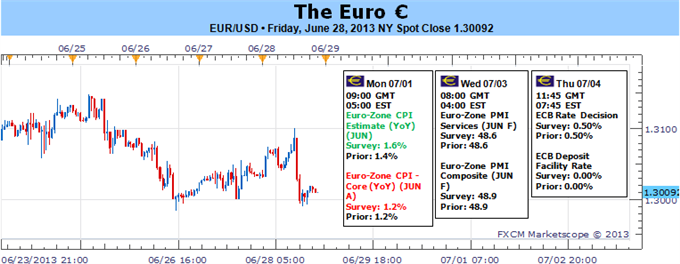
Euro Attempting to Avoid Crisis Conviction, ECB on Tap
Fundamental Forecast for Euro: Neutral
Greece risks another privatization deal falling through, Cyprus is downgraded
SSI shows retail traders have held short through EURUSD decline
EURUSD tumble slows, but yet to truly reverse
The euro’s performance was a mixed bag this past week with performance that ranged between a 0.9 percent drop against the dollar to a 0.5 percent gain versus the sterling. This varied bearing and general restraint speaks to quite the fundamental feat for the shared currency: stability despite developments like a Cypriot downgrade, Greece struggling to meet its bailout requirements and an EU summit that confirmed future banking crisis would be saddled on investors’ shoulders. Such optimism is the result of years of acclimatization to troubled conditions and buoyant global investor sentiment. Yet, with strength based on ideal conditions is a fragile state. Against a long-standing troubled fundamental backdrop, with risk appetite shuddering this past month and the ECB scheduled to deliberate on monetary policy this week; the threat of heavier selling isn’t too far off.
There is a difference between ‘potential’ and ‘probability’ when it comes to trading. The saying that ‘the trend is your friend’ is just as much a fundamental axiom as it is a technical one. Since the European Central Bank (ECB) introduced the – as yet untapped – Outright Monetary Transactions (OMT) and the Troika introduced Greece’s second rescue program, we have seen expectations for medium-term volatility stabilize at multi-year lows. With the EURUSD three-month implied volatility measure holding below 10 percent for the past 9 months, we see expectations of steady trading conditions moving forward. Those are encouraging, bullish conditions for a currency that is arguably still oversold after years of crisis-derived selling pressure. That is our ‘probability’ assessment.
On the other hand, the status quo is founded on a fragile set of conditions. Robust investor sentiment based on global stimulus efforts is essential for maintaining the optimistic assessment of ‘cheap’ European assets. If that peace were disrupted, it would open the flood gates to the reality of recession, growing social discontent and a financial system that has developed few solutions to a highly communicable feedback loop for crisis. In other words, if fear were to find its way back into the mainstream; European markets could erupt. That is the frightening ‘potential’ the euro faces.
As we follow the key fundamental events and data that dot the economic docket, we must remember that these catalysts’ influence can either be amplified or dampened by broader market sentiment. If, for example, a tentative unwind of specific QE3-based trades this past month were to escalate into full-blown deleveraging of risky assets (US and global equities, yen-based carry trades, etc); the appetite for depressed assets that has helped the euro will be replaced by a flight from risk that immediately shifts the focus back onto the region’s risks. For that reason, we must keep a very close eye on those strings that define market sentiment – most notably the relationship between risk appetite and central bank stimulus. The Fed’s change in guidance to suggest they may soon wean the market off its $85 billion-per-month QE3 program sent a jolt of panic through the market. It isn’t a difficult to see that the probability of a breakdown in confidence is catching up to severe potential it holds for the markets.
Keeping an eye on the delicate balance in the markets, we have a range of notable event risk due from the Euro-area moving forward. The most recognizable listing is the ECB’s policy decision. Following the May meeting where the group lowered the benchmark lending rate 25 bps (to 0.50 percent), the group has fallen back into its staid posture. A move by the European monetary authority is unlikely without financial market pressure to force their hand. The group has weathered record unemployment, recession and tepid inflation for months without reaction. As with the Fed, the most consequential changes are expected in guidance. Will the group make progress on the SME (small and medium enterprise) loan proposal which is in a fashion a targeted QE? Without the stress of an imminent crack in the market’s composure, they will likely just stick with the OMT backstop. Though, be especially wary of this taking place on a US holiday…
Outside the tidy time frame of the scheduled events and indicators through the coming weeks, it is important to also keep track of ‘fluid’ developments. This past week, it was reported that Greece is close to seeing its second privatization deal fall through. That jeopardizes future bailout disbursements and is certainly contributing to the rise in the country’s 10-year government bond yield –currently at 11 percent. Cyprus received downgrades to selective default by Fitch and Standard & Poor’s this past Friday after their planned €1 billion bond restructuring. Ireland’s ability to return to the financial markets has gained renewed attention after reporting an unexpected 1Q GDP drop. These are just a few of the threats lurking just beneath the surface the euro’s stability. –JK
— Written by: John Kicklighter, Chief Strategist for DailyFX.com
To contact John, email jkicklighter@dailyfx.com. Follow me on twitter at http://www.twitter.com/JohnKicklighter
Sign up for John’s email distribution list, here.
DailyFX provides forex news and technical analysis on the trends that influence the global currency markets.Learn forex trading with a free practice account and trading charts from FXCM.
Source: Daily fx

